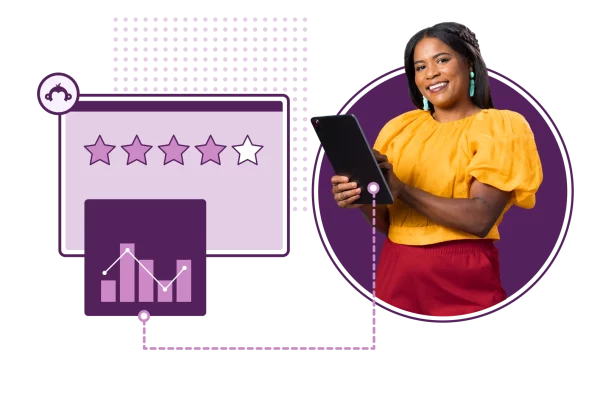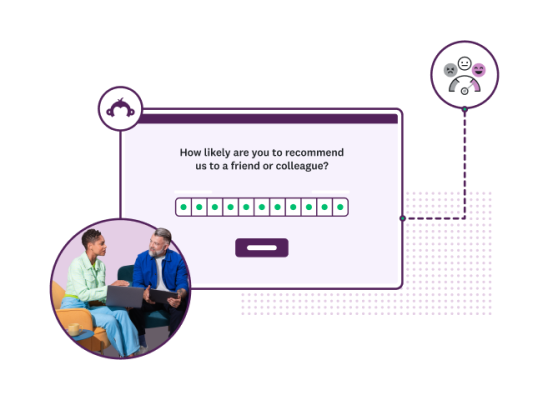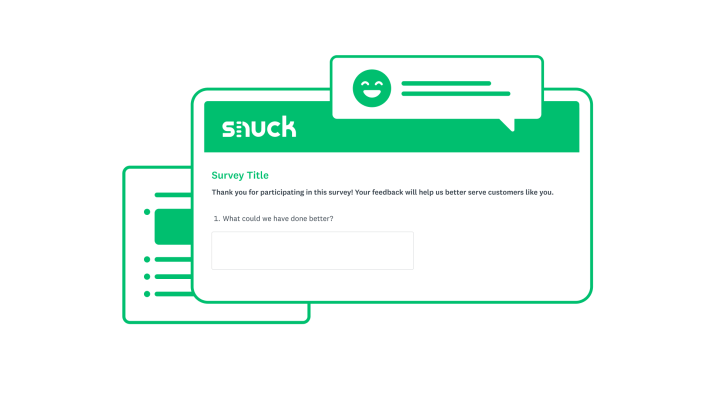NPS surveys: Best practices for high response rates

The Net Promoter Score® (NPS) is an important metric that helps determine customer satisfaction and loyalty. By collecting and acting upon data from NPS surveys, businesses can improve their customer-facing processes.
However, organizations must ensure that their customers respond to these surveys to make the most of this metric. Luckily, there are numerous strategies that your business can employ to achieve high response rates.
How to increase NPS survey response rates
Businesses should strive to increase survey response rates related to all customer experience processes.
Achieving a high NPS survey response rate will give you a comprehensive picture of customer satisfaction. A low response rate could misrepresent your data, lowering the integrity of your NPS score.
Several factors can influence your response rate:
- Your company’s industry.
- The method you use to distribute your NPS survey.
- When you send the survey.
- The actions that trigger you to send the survey.
A good NPS score will vary depending on the industry you work in. SurveyMonkey data demonstrates that the global average is around +32, but this will vary depending on your industry.
You should continuously record NPS data to set your business up for success. Producing an effective NPS survey, distributing it through appropriate channels, and setting success benchmarks will help increase survey response rates.
Let’s explore how you can create and distribute an NPS survey with a winning response rate.
How to build an effective, trustworthy NPS survey

Part of what makes an NPS survey so effective is its simplicity. Most of the time, your business will only need to include two questions. The standard NPS question is “How likely are you to recommend (insert business) to a friend or colleague?”
To provide context, you can also include an optional open-ended field. This second question will allow your customers to share insight into why they responded the way they did.
These two questions work fantastically together, providing a quantifiable metric and opinions for qualitative analysis. Additionally, keeping your NPS survey to a limit of two questions will avoid overwhelming your survey recipients. Short, clear, and unbiased questions will result in higher completion rates and more accurate answers.
One final step when creating an effective and trustworthy NPS survey is to include your personal branding. SurveyMonkey provides various survey customization options, like adding your logo, changing the design elements to match your branding, and changing the survey theme.
Changes that make a survey more aligned with your business are a good way of boosting its trustworthiness and increasing completion rates. Explore different NPS templates and see which offers your business the best results.
Choose the right NPS survey distribution method
The distribution method you use to share your NPS survey will radically impact response rates. Typically, the best delivery system will depend on how your customers interact with your business.
Here are a selection of potential survey distribution methods that can work in your favor:
- Email surveys
- In-app or in-product surveys
- Text message/SMS surveys
- In-store kiosk surveys
- Website surveys
Tailoring how you deliver your survey to your audience will make responding easy. If a customer has to go out of their way to fill in your survey, they are less likely to complete it.
Over time, you can test different distribution methods to see which offers your business the highest response rates.
Send NPS surveys at the right time
Sending out surveys with a low frequency will result in sporadic and reliable data. Alternatively, sending surveys out too often can result in survey fatigue, lowering response rates. Your business should determine the optimal time to send out a survey.
A useful strategy to consider is creating two schedules for NPS survey interactions: relational NPS and transactional NPS.
A relational NPS is a survey you send out regularly throughout the year. This form of NPS will give you a comprehensive understanding of how a customer’s relationship with your company changes and evolves over a year.
A transactional NPS is a survey you send out after a customer completes a specific action. For example, when a customer purchases from your business, you can survey them to determine the quality of their most recent interaction.
Using these two schedules of sending out NPS surveys, you can comprehensively understand your customer’s perceptions of your business. A relational NPS will help you set and monitor your overall NPS benchmarks. On the other hand, a transactional NPS will provide insight into the quality of your customer interaction around purchasing actions.
To better understand when to survey your customers over the year, it can be helpful to monitor your customer journey map. Mapping the customer journey will help you balance surveying at the right time and avoiding over-surveying.
Read our ultimate guide to customer journey mapping to discover how to best approach your audience.
How to drive excellent NPS email open rates
Delivering NPS surveys via email is typically one of the leading ways of achieving high response rates. However, this is only if your business handles the process effectively. With lots of email spam regularly arriving at customer accounts, you must stand out.
Here are some strategies to drive high NPS email open rates.
Build attention-grabbing email subject lines
The subject line of an email should be able to speak for itself. If you use a generic or uninteresting subject line, customers may skip over your email altogether. Instead, try to think and deploy attention-grabbing email subject lines.
If you can capture your audience's attention from the subject line, they will be more likely to open your NPS email.
Ensure the sender's name is credible
Customers are more likely to open an NPS survey email if it arrives from a credible address. Use a work email and an employee’s name with a credible title.
Alternatively, you can email your NPS survey from your company’s main account. The formality of this will help to prove the credibility of the email and boost open rates.
Send surveys based on the recipient's time zone
For companies with an international customer base, sending out NPS emails simultaneously can lead to extremely low open rates. The time to send for your customers on the West Coast might be the middle of the night for customers in the UK.
Understanding time zones and staggering your sending times accordingly will help to improve open rates. Use the recipient’s timezone as a deciding factor when sending out your NPS survey emails.
Continually optimize
Another strategy to improve NPS email open rates is to use A/B testing. A/B testing allows you to modify small elements of your NPS email to determine the better course of action. You can test out the NPS email's design elements, copy, subject lines, and other core elements.
You'll boost open rates by continuously improving your NPS email strategy with A/B testing.
Automate NPS surveys after key milestones
Automating sending NPS surveys can be a powerful way of achieving high response rates. Automation allows your business to send surveys immediately after a customer completes a milestone. Customers provided with this opportunity are more likely to respond as the event itself is still fresh in their minds. Integrating surveys into your applications and triggering them at certain moments can capture more responses.
Here are several typical milestones that you can use as event triggers:
- A customer completes a purchase
- A customer receives an item
- After a customer support interaction
Your business can experiment with how long you send the survey after this milestone for the best response rates. For example, the individual will be allowed to share their feelings about that specific interaction directly after a customer support interaction. This scenario thrives off a short lead time between the event and sending the survey.
Alternatively, you could send out an NPS survey 2-3 days after your product arrives with a customer. This longer lead time will give the customer enough time to formulate an opinion and provide more meaningful insights.
Experimenting with the milestones your businesses use as automatic NPS triggers and when they occur can help improve response rates over time.
Always follow up on feedback received in NPS surveys

Closing the feedback loop by relying on NPS survey responses demonstrates your commitment to your customers. After all, why would customers want to fill out a survey if they didn’t think your business took their comments seriously?
Outlining your steps based on customer feedback will show your customers you care. This approach will help improve customer relationships and win new NPS promoters.
Ensure customer data is stored securely
Outlining the steps you will take based on customer feedback will show your customers you care. This approach will help improve customer relationships and win new NPS promoters.
Outlining the steps you have taken to protect their data can greatly reassure them.
Build NPS surveys with SurveyMonkey that drive response rates
Achieving high NPS survey response rates results from actively improving your survey processes. From understanding the best times to send out your survey to refining how you structure your NPS question, you can boost response rates in multiple ways. By following the advice in this article, you’ll be reaching toward 100% completion in no time.
NPS score data is vital for businesses that want to improve customer satisfaction. By refining your surveying method, you’ll be able to gather more comprehensive customer data. From there, you can build actionable plans to boost customer loyalty and satisfy customers across their entire journey with your company.
Learn how SurveyMonkey can help you build a loyal customer base.
NPS, Net Promoter & Net Promoter Score are registered trademarks of Satmetrix Systems, Inc., Bain & Company, and Fred Reichheld.
Discover more resources

Customer satisfaction survey templates
Explore our customer satisfaction survey templates to rapidly collect data, identify pain points, and improve your customer experience.

3 ways to boost business growth by connecting SurveyMonkey and HubSpot
See how users are taking action on survey data to improve customer experience with the SurveyMonkey app for HubSpot.

How to use Forms to enhance your survey experience
How do surveys and forms differ? Learn how to combine form data with survey feedback for seamless events and experiences.

Beyond CX: How SurveyMonkey + Salesforce turn feedback into revenue
SurveyMonkey + Salesforce turn feedback into revenue